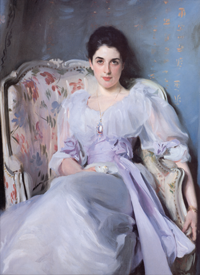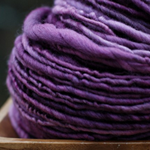Perspectives on Purple
In ancient Greece, Bogey the Bearcat might have been called porphyrous. According to the Merriam-Webster Dictionary, the word “purple” is derived from the Greek porphyra or porphyrous, a seldom used adjective describing “someone that has a purple color.”
McKendree’s official color appears on everything from logos, athletic jerseys and
diploma covers to T-shirts, street banners and rubber wristbands. In the fight song,
we promise to “honor the purple and white.”
Mention purple to art professor David Ottinger and “two paintings come to mind instantly:
John Singer Sargent’s portrait of “Lady Agnew,” most likely the most lovely painting
of a women dressed in purple ever painted, and Renoir’s ‘Purple Landscape’.”
A scientist offers another perspective. “Purple color opens our eyes to the colors
of the world at the high energy end of the visible spectrum,” explains Dr. Feza Ozturk,
professor of chemistry.
“Our eyes are blind to most wavelengths of the electromagnetic spectrum. We can only
see the wavelengths of light between 0.7 micrometer (lowest energy) and 0.4 micrometer
(highest energy) where the purple wavelength is located. After purple, the unseen
world of ultraviolet starts.”
In an English class, “purple prose” describes writing that is flowery, overly descriptive
or self-indulgent. “It was a dark and stormy night,” the most infamous example, was
first penned by Edward Bulwer-Lytton, a 19th century English nobleman and novelist.
(He also gave us “the “almighty dollar” and “the pen is mightier than the sword.”)
An annual contest named for him rewards fiction writers for creative use of extravagant,
over-the-top language.
“When I am an old woman, I shall wear purple, with a red hat which doesn’t go, and
doesn’t suit me,” wrote English authorjournalist Jenny Joseph in 1961. The opening
lines of her poem “Warning” celebrates aging with a carefree attitude and later inspired
the Red Hat Society for ladies 50 and older.
Purple reminds Dr. Darryn Diuguid, assistant professor of education, of… Danitra Brown.
“My Children’s Literature class reads the award-winning book Meet Danitra Brown, by poet Nikki Grimes,” he says. “In the poem, ‘Purple’ she writes, ‘Danitra is most
splendiferous girl in town,’ and ‘if you see a girl in purple, it must be Danitra
Brown.’ It makes me think she would fit in perfectly at McKendree.”
“At many competitions, a blue ribbon designates a first place winner but a purple
ribbon designates a champion—the winner chosen from all of the first place winners,”
points out Dr. Brenda Doll, assistant professor and director of teacher education.
“Many of life’s great lessons can be learned on the playing field,” notes Dr. Deanne
Riess, associate professor of health and physical education, drawing a comparison
to the battlefield. “In athletics and sport one might say there are moments of bravery
and courage displayed at many different levels.” The Purple Heart, awarded for being
wounded in combat or given posthumously to one’s next of kin, is a symbol of bravery
and courage. It is the U.S. military’s oldest medal; the original cloth Purple Heart ribbon was given by General George
Washingtonto only three soldiers during the American Revolution.
oldest medal; the original cloth Purple Heart ribbon was given by General George
Washingtonto only three soldiers during the American Revolution.
“Historically, purple wampum was the most valued and valuable wampum among northeastern
Native Americans,” says Dr. Pat Folk, Deneen Memorial Professor of History. They wove
the tubular beads made from mollusk shells into belts and  exchanged them as currency with the colonists. The distinctive purple edge on the
shell of the quahog clam Mercinaria mercinaria remains highly prized for ornamental and ceremonial use.
exchanged them as currency with the colonists. The distinctive purple edge on the
shell of the quahog clam Mercinaria mercinaria remains highly prized for ornamental and ceremonial use.
The Minoans—a Bronze Age civilization on the island of Crete—and later the Phoenicians,
were the first to develop a purple dye, drop by drop from mollusks found along the
eastern Mediterranean shore near Tyre. Rare and difficult to obtain, “Tyrian purple”
became associated with wealth and royalty.
